ARS - Pioneers in Fruit and Vegetable Research
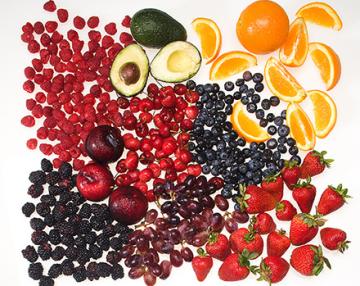
USDA scientists have made tremendous contributions to fruit and vegetable farming, including domesticating the wild blueberry and developing virus-free strawberries. (Photo by Stephen Ausmus, D833-1)
In recognition of the United Nations proclamation of 2021 as The Year of Fruits and Vegetables, Tellus takes a look at how ARS has helped to improve fruit and vegetable production. (See Part 2)
When the U.S. Department of Agriculture was created in 1862, more than half of America’s labor force were farmers. From the start, USDA researchers collaborated with fruit and vegetable growers to help meet their biggest challenges. USDA scientists made tremendous contributions to fruit and vegetable farming, including:
-
determining the cause of the Irish potato famine
-
domesticating the wild blueberry
-
developing virus-free strawberries
-
creating official USDA grade standards for fruits and vegetables
-
guiding farmers out of the worst drought in U.S. history, the Dust Bowl
USDA formally established the Agricultural Research Service (ARS) in 1953, and since then, ARS researchers have had a significant impact on the farming industry, even helping to save some industries from devastation. ARS National Program Leader Joseph Munyaneza pointed to the potato industry as a recent example.
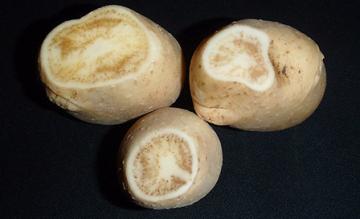
Tubers infected with zebra chip disease show dark, stripelike symptoms in the tissue. ARS scientists have given potato growers tools to manage and mitigate the disease. (Photo by Joseph Munyaneza, D2395-1)
Zebra Chip
In the early-to-mid 2000s, a serious disease was threatening potato crops across the Midwest. Growers were seeing dark blotches or stripes on their crop leaves, which would then quickly deteriorate. ARS researchers determined the disease was “zebra chip,” which was caused by a bacterium and spread by an insect.
“We quickly figured out that tiny insects were the cause, but we didn’t know how they were spreading the disease,” Munyaneza said. “Once we learned the insects were carrying the disease, we worked on ways to eradicate both the insects and disease.”
Zebra chip disease still exists today, but potato growers now have the tools to manage and mitigate it.
“Some of the most impressive things ARS has done have revolved around how we respond to crises,” said ARS National Program Leader Timothy Rinehart. “When these diseases first emerge, they can really shake things up. But, because we’re already working closely with growers, we can quickly address the issues.”
ARS Innovation
Munyaneza sees ARS technological innovations as a major force behind farming improvements and sustainability over the years.
“Especially with specialty crops, technology has played a huge role in improving productivity,” he said.
One recent innovation is the precision sprayer. It’s an intelligent spray-control system that uses laser vision to map the size, shape, and foliage density of a tree or plant and then applies a custom dose of pesticide. Field tests showed the precision sprayer could reduce spray drift by up to 87 percent and pesticide use between 30 percent and 85 percent.
“This precision sprayer has revolutionized everything, because it can adapt to different size and shaped crops, and you can be very precise to where it is spraying,” said Munyaneza.
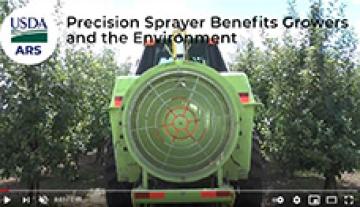
ARS researchers and partners developed a precision sprayer that benefits growers and the environment. Watch a video
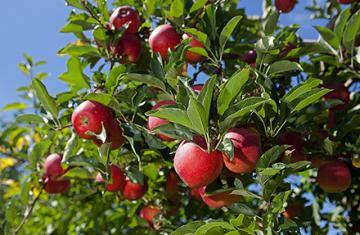
ARS scientists have created dozens of apple and citrus rootstocks that have been valuable to growers. (Photo by Peggy Greb, D3539-1)
Rootstocks
ARS scientists have created dozens of apple and citrus rootstocks that have been valuable to growers, and they’re applying that expertise to many other crops, such as tomatoes, melons, and berries. New rootstocks can provide consumers with more variety and growers with improved farming practices and increased yield and profitability.
Creating new rootstocks has also been pivotal in helping growers deal with new and emerging pests and diseases.
“It’s a huge long-term investment,” said Rinehart, “but ARS rootstocks in apple, peach, and citrus have all been game-changers.”
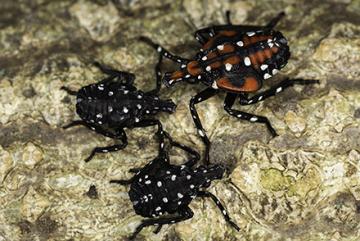
Spotted lanternfly (Lycorma delicatula) 2nd and 3rd instar nymph (black); 4th instar nymph (red body). ARS successfully reconstructed the spotted lanternfly’s genome, opening the door for researchers to study effective ways to control and mitigate the invasive pest. (Photo by Stephen Ausmus, D4016-6)
Ongoing Threats
Pierce’s disease, citrus greening disease, the brown marmorated stink bug, and the spotted lanternfly continue to threaten entire crop industries. ARS has expended significant resources to detect, prevent, and mitigate these dangerous pests and diseases. In 2020, ARS created a competition, called ARSX, to address disruptive pests and pathogens in an innovative manner with potential for scalable results.
“Some of these problems don’t go away, so we have to adapt and keep working on them,” said Rinehart. “We’re going on almost 15 years with Pierce's disease in grapes, and we’re still putting a lot of time and effort into helping growers deal with it and contain it.”
Other problems are relatively new, like the appearance of the spotted lanternfly. Both Rinehart and Munyaneza see this pest as a major concern among growers across different industries. In 2020, ARS successfully reconstructed the spotted lanternfly’s genome, opening the door for researchers to study effective ways to control and mitigate the invasive pest.
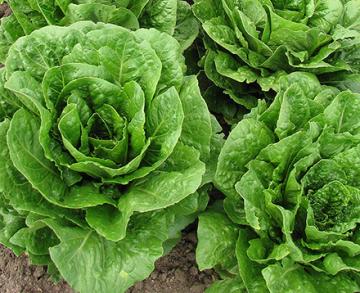
Above are romaine lettuce heads. ARS is working closely with the leafy green industry to address food safety and quality. (Photo by Jose Orozco, D3416-1)
Living in the Present
Along with pests and diseases, Munyaneza cited soil health and food safety as major concerns for today’s growers. For example, product recalls of leafy greens have raised two significant questions for this industry: 1) how to control disease prevalence during washing, packing, shipping, and storage; and 2) how to re-instill consumer confidence that leafy greens are safe to eat.
“This is not an easy fix because we also want to make sure we’re not changing the quality of the product,” Munyaneza said. “We are working closely with the leafy green industry to address food safety and quality.”
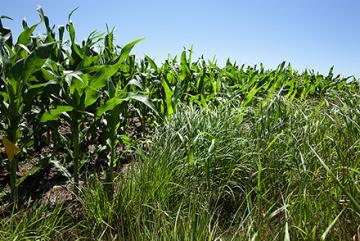
Switchgrass (right) and no-till corn growing in Nebraska in a soil carbon sequestration study. (Photo by Peggy Greb, D2611-1)
A Changing Climate
One of the most pervasive issues across all commodities is climate change, noted Rinehart. Growers face challenges related to floods, drought, extreme weather, and unpredictable growing seasons, and must balance these challenges with efforts to become more environmentally friendly and sustainable to feed a growing population.
“And that’s just our efforts in adapting to climate change,” he said. “There is a new push to mitigate climate change, which means these same cropping systems now need to reduce greenhouse gas emissions and store carbon so farmers can get paid for agroecosystems services. It’s a tough challenge for researchers and farmers alike.”
ARS fruit and vegetable breeders, soil ecologists, and other scientists are committed to developing crops that require less water, are more disease resistant, can be grown under a myriad of weather conditions, and enable carbon to return to the ground. – By Todd Silver, ARS Office of Communications.

